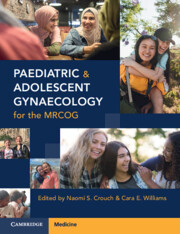Book contents
- Paediatric and Adolescent Gynaecology for the MRCOG
- Paediatric and Adolescent Gynaecology for the MRCOG
- Copyright page
- Contents
- Contributors
- Introduction
- Chapter 1 Embryological Development of the Internal and External Female Genitalia
- Chapter 2 Gynaecological History and Examination in Children and Adolescents
- Chapter 3 Normal and Precocious Puberty
- Chapter 4 Common Prepubertal Problems in Paediatric Gynaecology
- Chapter 5 Adolescent Menstrual Dysfunction
- Chapter 6 Polycystic Ovary Syndrome in Adolescence
- Chapter 7 Müllerian Duct Anomalies
- Chapter 8 Primary Amenorrhoea and Delayed Puberty
- Chapter 9 Rokitansky Syndrome
- Chapter 10 Turner Syndrome
- Chapter 11 Differences in Sex Development
- Chapter 12 Premature Ovarian Insufficiency
- Chapter 13 Gynaecological Laparoscopy in Adolescents
- Chapter 14 Psychology in Paediatric and Adolescent Gynaecology
- Chapter 15 Legal and Ethical Aspects of Paediatric and Adolescent Gynaecology
- Index
- References
Chapter 14 - Psychology in Paediatric and Adolescent Gynaecology
Published online by Cambridge University Press: 28 January 2023
- Paediatric and Adolescent Gynaecology for the MRCOG
- Paediatric and Adolescent Gynaecology for the MRCOG
- Copyright page
- Contents
- Contributors
- Introduction
- Chapter 1 Embryological Development of the Internal and External Female Genitalia
- Chapter 2 Gynaecological History and Examination in Children and Adolescents
- Chapter 3 Normal and Precocious Puberty
- Chapter 4 Common Prepubertal Problems in Paediatric Gynaecology
- Chapter 5 Adolescent Menstrual Dysfunction
- Chapter 6 Polycystic Ovary Syndrome in Adolescence
- Chapter 7 Müllerian Duct Anomalies
- Chapter 8 Primary Amenorrhoea and Delayed Puberty
- Chapter 9 Rokitansky Syndrome
- Chapter 10 Turner Syndrome
- Chapter 11 Differences in Sex Development
- Chapter 12 Premature Ovarian Insufficiency
- Chapter 13 Gynaecological Laparoscopy in Adolescents
- Chapter 14 Psychology in Paediatric and Adolescent Gynaecology
- Chapter 15 Legal and Ethical Aspects of Paediatric and Adolescent Gynaecology
- Index
- References
Summary
Many young people seen in paediatric and adolescent gynaecology (PAG) clinics will be distressed and will be accompanied by distressed parents, carers or partners. Good multi-professional care can understand these natural and normal emotional and psychological responses. Aspects of physical development are increasingly characterised as natural variations rather than pathologies. Some previously routine PAG procedures, such as sex-affirming genital surgery, are now identified as socially motivated. All PAG practitioners need to develop a deeper understanding of those that are seeking their help to achieve optimal personal development.
- Type
- Chapter
- Information
- Paediatric and Adolescent Gynaecology for the MRCOG , pp. 109 - 118Publisher: Cambridge University PressPrint publication year: 2023



